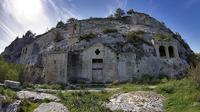Guided Tour of Italy's Sassi di Matera: Parco della Murgia Materana - Murgia Materana Park
Matera, Italy
Trip Type: Walking Tours
Duration: 3 hours
Join your expert guide on this 3-hour guided tour of the Italian province Materana, with the first stop at the Archaeological Historical-Natural Park of the Rupestrian Churches of Matera. In the Murgia Park, there are 150 rupestrian churches, different in architecture and iconography, made mostly in the Middle Ages. These churches now represent an important evidence of human presence, in particular relation to the Benedictine monks, Lombards and Byzantines. The Murgia plateau acts as a natural backdrop to this scenario where you will walk on a paleosol of prehistoric fossil-rich rangoli that transports visitors on a journey through time and space.
More About This Activity All Walking Tours →
Join your expert guide on this 3-hour guided tour of the Italian province Materana, with the first stop at the Archaeological Historical-Natural Park of the Rupestrian Churches of Matera. In the Murgia Park, there are 150 rupestrian churches, different in architecture and iconography, made mostly in the Middle Ages. These churches now represent an important evidence of human presence, in particular relation to the Benedictine monks, Lombards and Byzantines. The Murgia plateau acts as a natural backdrop to this scenario where you will walk on a paleosol of prehistoric fossil-rich rangoli that transports visitors on a journey through time and space.Archaeological Historical-Natural Park of the Rupestrian Churches of Matera, also called Parco della Murgia Materana, is a regional park of Basilicata. Since 2007, the definition of Sassi di Matera in the list of UNESCO World Heritage Sites has expanded to include Sassi and the Park of the Rupester Churches of Matera.
The Park, located between the towns of Matera and Montescaglioso in Basilicata, is characterized by a soft rock called "limestone," which played an essential role in the forms assumed by the landscape, drawing cliffs, gorges and caves. Just a few kilometers away from the border of Puglia, Murgia Park has 150 rock churches, different in architecture and iconography, made mostly in the Middle Ages. What's most surprising is that despite being born as places of worship, the churches have, over time, also been used as homes or places of shelter for animals.
These churches now represent an important evidence of human presence, in particular relation to the Benedictine monks, Lombards and Byzantines. The Murgia plateau acts as a natural backdrop to this scenario, with many rock churches scattered along the slopes of ravines, protected by the institution of the Park Archeologico of the Rock Churches of Matera, also called Parco della Murgia Materana.
The Park is very charming, engulfed by ravines with cultivated areas and some survival of the ancient Mediterranean culture. There are also fortified farms, as well as lively and fascinating paths carved into the rock to collect water in cisterns, wells and water troughs—all evidence of the centuries-old agro-pastoral development.
You will walk on a paleosol of prehistoric fossil-rich rangoli that transports visitors on a journey through time and space. Return to the original departure point to the Piazza Vittorio Veneto where you can enjoy tasting of local products at your own expense.
The Park, located between the towns of Matera and Montescaglioso in Basilicata, is characterized by a soft rock called "limestone," which played an essential role in the forms assumed by the landscape, drawing cliffs, gorges and caves. Just a few kilometers away from the border of Puglia, Murgia Park has 150 rock churches, different in architecture and iconography, made mostly in the Middle Ages. What's most surprising is that despite being born as places of worship, the churches have, over time, also been used as homes or places of shelter for animals.
These churches now represent an important evidence of human presence, in particular relation to the Benedictine monks, Lombards and Byzantines. The Murgia plateau acts as a natural backdrop to this scenario, with many rock churches scattered along the slopes of ravines, protected by the institution of the Park Archeologico of the Rock Churches of Matera, also called Parco della Murgia Materana.
The Park is very charming, engulfed by ravines with cultivated areas and some survival of the ancient Mediterranean culture. There are also fortified farms, as well as lively and fascinating paths carved into the rock to collect water in cisterns, wells and water troughs—all evidence of the centuries-old agro-pastoral development.
You will walk on a paleosol of prehistoric fossil-rich rangoli that transports visitors on a journey through time and space. Return to the original departure point to the Piazza Vittorio Veneto where you can enjoy tasting of local products at your own expense.
« Go Back

